Bryant G. Wood | |
|---|---|
| Born | 1936 (age 87–88) Endicott, New York, U.S. |
| Nationality | American |
| Alma mater | Syracuse University (BS) Rensselaer Polytechnic Institute (MS) University of Michigan (MA) University of Toronto (PhD) |
| Known for | Reassessment of Garstang's and Kenyon's Jericho datings |
| Scientific career | |
| Fields | Archaeology |
| Institutions | Editor of Bible and Spade |
Bryant G. Wood (born 1936) is an American biblical archaeologist and Young Earth creationist. Wood is known for arguing that the destruction of Jericho could be accorded with the biblical literalist chronology of c. 1400 BC. This date is some 150 years later than the accepted date of c. 1550 BC, first determined by Kathleen Kenyon and subsequently confirmed with radiocarbon dating. [1]
Wood attended Syracuse University, graduating with a B.S. in mechanical engineering, later earning an M.S. in mechanical engineering from Rensselaer Polytechnic Institute in Troy, New York. He later pursued biblical and archaeological studies and received an M.A. in Biblical History from the University of Michigan in 1974 and a PhD in Syro-Palestinian archaeology from the University of Toronto in 1985. Wood is a specialist in Canaanite pottery of the Late Bronze Age. He is the author of The Sociology of Pottery in Ancient Palestine: The Ceramic Industry and the Diffusion of Ceramic Style in the Bronze and Iron Ages (1990), as well as numerous articles on archaeological subjects. He received international attention for his proposed redating of ancient Jericho, arguing for the historicity of a biblically literalist account of the capture of the city by the Israelites. He has also written on the entry of the Philistines into Canaan and on the historicity of the Biblical story of Sodom and Gomorrah.
He is a member of the Board of Directors of the Near East Archaeological Society. [2]
Wood serves as editor in chief of the quarterly publication Bible and Spade (published by the inerrantist organisation Associates for Biblical Research), which describes itself as "[a] Christian Apologetics Ministry Dedicated to Demonstrating the Historical Reliability of the Bible through Archaeological and Biblical Research". [3] The magazine concentrates largely on matters relating to archaeology and Bible history, but also touches on general apologetics (especially the relationship between science and evangelical religious belief) and Christian devotion. [4] Bible and Spade is a quarterly magazine committed to the use of archaeology to demonstrate the historical veracity of the Old and New Testaments. [5] [6] The editor-in-chief is listed as Wood. The headquarters is in Akron, PA.
It states its creationist commitment as follows:
Wood is also a contributor to the Biblical Archaeology Review , the Israel Exploration Journal and the Near East Archaeological Society Bulletin .
During a series of excavations from 1930 to 1936 John Garstang found a destruction layer at Jericho corresponding to the termination of City IV which he identified with the biblical story of Joshua and dated to c. 1400 BC. [8] It was therefore a shock when Kathleen Kenyon in the 1950s, using more scientific methods than had been available to Garstang, redated Jericho City IV to 1550 BC and found no signs of any habitation at all for the period around 1400 BC. Wood's 1990 reversion of City IV to Garstang's original 1400 BC therefore attracted considerable attention. Wood based his belief on the story in the biblical book of Joshua, Jericho was the first Canaanite city to fall to the Israelites as they began their conquest of the Promised Land - an event which Wood places at around 1406 BC due to his interpretation of 1 Kings 6:1. In 1999, based on a reanalysis of pottery shards, Wood argued that Jericho could have been captured in the Late Bronze Age by Joshua. [9] Wood and Piotr Bienkowski debated this in the March/April 1990 issue of Biblical Archaeology Review , with Bienkowski writing:
Wood has attempted to redate the destruction of Jericho City IV from the end of the Middle Bronze Age (c. 1550 B.C.) to the end of the Late Bronze I (c. 1400 BC). He has put forward four lines of argument to support his conclusion. Not a single one of these arguments can stand up to scrutiny. On the contrary, there is strong evidence to confirm Kathleen Kenyon's dating of City IV to the Middle Bronze Age. Wood's attempt to equate the destruction of City IV with the Israelite conquest of Jericho must therefore be rejected. [10]
Wood responded that he had produced evidence to back his argument, and that any counter-claims should also be backed by fresh evidence. [11] In 1995 new evidence became available in the form of charred cereal grains from the City IV destruction layer. Radiocarbon dating of these grains showed that Jericho City IV was destroyed "during the late 17th or the 16th century BC", in line with Kenyon's findings, and that "the fortified Bronze Age city at Tell es-Sultan [Jericho] was not destroyed by ca.1400 BC, as Wood suggested". [12] Wood responded to the newer evidence in an article for the Bible and Spade magazine, concluding that he still held to the date ca. 1400 B.C. based on pottery finds. [13] Wood also argues [14] that the discrepancy is part of the ongoing dispute between Egyptologists and radiocarbon experts that centers around the date of the Thera eruption. Kenyon's date is consensually accepted by mainstream archaeologists. [1] William G. Dever dismissed Wood's theories stating: "Of course, for some, that only made the Biblical story more miraculous than ever—Joshua destroyed a city that wasn't even there!" [15] According to Ann E. Killebrew, "Most scholars today accept that the majority of the conquest narratives in the book of Joshua are devoid of historical reality". [16]
Wood directed excavations at Khirbet el-Maqatir, [17] a city which he and his associates contend may be the biblical city of Ai. [18] (The traditional location of Ai, et-Tell, was excavated most recently by Joseph Callaway and was found to have been abandoned during the entirety of the Middle Bronze and Late Bronze Ages.) Khirbet el-Maqatir has produced pottery of the Early Bronze, Middle Bronze, Late Bronze I, Iron Age I, late Hellenistic/early Roman, and Byzantine periods. Based on initial finds, including a small Late Bronze I fortress that was destroyed by fire - some two centuries earlier than the date usually considered for the events of Book of Joshua - their "preliminary conclusion is that the LB I fortress meets the Biblical requirements to be tentatively identified as the fortress Ai, referred to in Josh. 7–8." [19] They see a nearby wadi as the hiding place of the Israelites before the ambush, and they have found that the fortress had a gate. These points fit the limited and commonplace topographic details ascribed to Ai in the Bible.
This identification has not gained acceptance. [20] [21] The present-day consensus is that there never was an Israelite conquest of Canaan. [22] [23]
Wood is an evangelical Christian. He supports biblical literalism and considers himself a Young Earth creationist. He is married to Faith Wood, and lives in Manheim, Pennsylvania. [2]
The current scholarly consensus follows the conclusion of Kenyon: Except for a small, short-lived settlement (ca. 1400 B.C.), Jericho was completely uninhabited ca. 1550-1100 B.C.
(Of course, for some, that only made the Biblical story more miraculous than ever—Joshua destroyed a city that wasn't even there!)

The Book of Joshua is the sixth book in the Hebrew Bible and the Old Testament, and is the first book of the Deuteronomistic history, the story of Israel from the conquest of Canaan to the Babylonian exile. It tells of the campaigns of the Israelites in central, southern and northern Canaan, the destruction of their enemies, and the division of the land among the Twelve Tribes, framed by two set-piece speeches, the first by God commanding the conquest of the land, and, at the end, the second by Joshua warning of the need for faithful observance of the Law (torah) revealed to Moses.

Joshua, also known as Yehoshua, Jeshoshua, or Josue, functioned as Moses' assistant in the books of Exodus and Numbers, and later succeeded Moses as leader of the Israelite tribes in the Book of Joshua of the Hebrew Bible. His name was Hoshea the son of Nun, of the tribe of Ephraim, but Moses called him "Yehoshua", the name by which he is commonly known in English. According to the Bible, he was born in Egypt prior to the Exodus.

Dame Kathleen Mary Kenyon, was a British archaeologist of Neolithic culture in the Fertile Crescent. She led excavations of Tell es-Sultan, the site of ancient Jericho, from 1952 to 1958, and has been called one of the most influential archaeologists of the 20th century. She was Principal of St Hugh's College, Oxford, from 1962 to 1973, having undertaken her own studies at Somerville College, Oxford.

Canaan was a Semitic-speaking civilization and region of the Southern Levant in the Ancient Near East during the late 2nd millennium BC. Canaan had significant geopolitical importance in the Late Bronze Age Amarna Period as the area where the spheres of interest of the Egyptian, Hittite, Mitanni, and Assyrian Empires converged or overlapped. Much of present-day knowledge about Canaan stems from archaeological excavation in this area at sites such as Tel Hazor, Tel Megiddo, En Esur, and Gezer.

Bethel was an ancient Israelite city and sacred space that is frequently mentioned in the Hebrew Bible.

Et-Tell or Khirbet et-Tell is an archaeological site in the West Bank, commonly identified with the biblical city of Ai.

Tel Megiddo, called in Arabic Tell el-Mutesellim, 'Mound of the Governor', is the site of the ancient city of Megiddo, the remains of which form a tell, situated in northern Israel near Kibbutz Megiddo, about 30 kilometres (19 mi) south-east of Haifa, at the western edge of the Jezreel Valley. Megiddo is known for its historical, geographical, and theological importance, especially under its Greek name Armageddon. During the Bronze Age, Megiddo was an important Canaanite city-state. During the Iron Age, it was a royal city in the Kingdom of Israel.
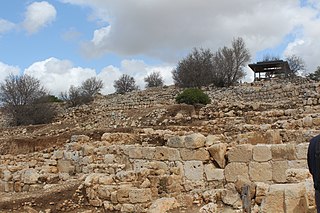
Shiloh was an ancient city and sanctuary in ancient Israel located in the region of Samaria. According to the Hebrew Bible, Shiloh was one of the main centers of Israelite worship during the pre-monarchic period, before the First Temple in Jerusalem was built. After the Israelite conquest of Canaan, the Tabernacle was moved to Shiloh, and remained there during the period of the biblical judges.
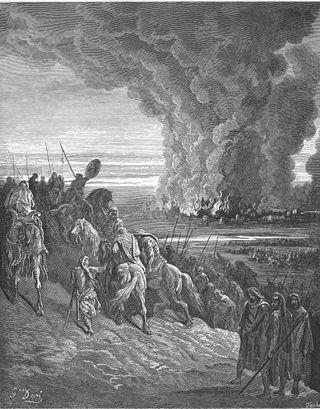
The Ai was a city in Canaan, mentioned in the Hebrew Bible. According to the Book of Joshua, it was conquered by the Israelites, headed by Joshua, during their conquest of Canaan.

Tel Rehov or Tell es-Sarem, is an archaeological site in the Bet She'an Valley, a segment of the Jordan Valley, Israel, approximately 5 kilometres (3 mi) south of Beit She'an and 3 kilometres (2 mi) west of the Jordan River. It was occupied in the Bronze Age and Iron Age.

Israel Finkelstein is an Israeli archaeologist, professor emeritus at Tel Aviv University and the head of the School of Archaeology and Maritime Cultures at the University of Haifa. Finkelstein is active in the archaeology of the Levant and is an applicant of archaeological data in reconstructing biblical history. Finkelstein is the current excavator of Megiddo, a key site for the study of the Bronze and Iron Ages in the Levant.
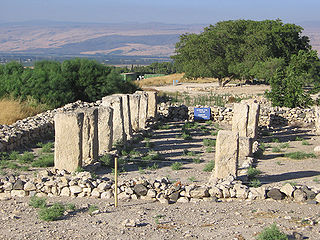
Tel Hazor, also Chatsôr, translated in LXX as Hasōr, named in Arabic Tell Waqqas / Tell Qedah el-Gul, is an archaeological tell at the site of ancient Hazor, located in Israel, Upper Galilee, north of the Sea of Galilee, in the northern Korazim Plateau. From the Middle Bronze Age to the Iron Age, Hazor was the largest fortified city in the region and one of the most important in the Fertile Crescent. It maintained commercial ties with Babylon and Syria, and imported large quantities of tin for the bronze industry. In the Book of Joshua, Hazor is described as "the head of all those kingdoms". Though scholars largely do not consider the Book of Joshua to be historically accurate, archaeological excavations have emphasized the city's importance.
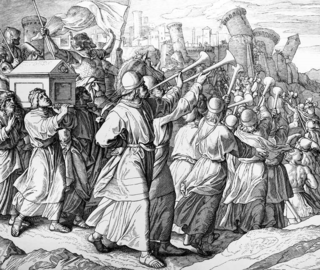
The Battle of Jericho, as described in the Biblical Book of Joshua, was the first battle fought by the Israelites in the course of the conquest of Canaan. According to Joshua 6:1–27, the walls of Jericho fell after the Israelites marched around the city walls once a day for six days, seven times on the seventh day, with the priests blowing their horns daily and the people shouting on the last day. Excavations at Tell es-Sultan, the biblical Jericho, have failed to find any traces of a city at the relevant time, which has led to a consensus among scholars that the story has its origins in the nationalist propaganda of much later kings of Judah and their claims to the territory of the Kingdom of Israel. The lack of archaeological evidence and the composition, history and theological purposes of the Book of Joshua have led archaeologists like William G. Dever to characterise the story of the fall of Jericho as "invented out of whole cloth".
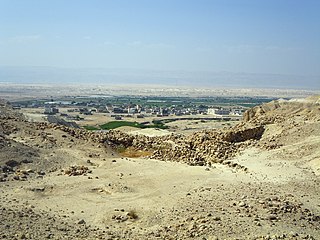
Bab edh-Dhra is the site of an Early Bronze Age city located near the Dead Sea, on the south bank of Wadi Kerak with dates in the EB IB, EB II, EB III and EB IVA. Bab edh-Dhra was discovered in 1924 on an expedition led by William F. Albright.
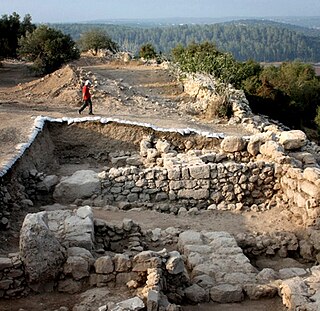
KhirbetQeiyafa, also known as Elah Fortress and in Hebrew as Horbat Qayafa, is the site of an ancient fortress city overlooking the Elah Valley and dated to the first half of the 10th century BCE. The ruins of the fortress were uncovered in 2007, near the Israeli city of Beit Shemesh, 30 km (20 mi) from Jerusalem. It covers nearly 2.3 ha and is encircled by a 700-meter-long (2,300 ft) city wall constructed of field stones, some weighing up to eight tons. Excavations at site continued in subsequent years. A number of archaeologists, mainly the two excavators, Yosef Garfinkel and Saar Ganor, have claimed that it might be one of two biblical cities, either Sha'arayim, whose name they interpret as "Two Gates", because of the two gates discovered on the site, or Neta'im; and that the large structure at the center is an administrative building dating to the reign of King David, where he might have lodged at some point. This is based on their conclusions that the site dates to the early Iron IIA, ca. 1025–975 BCE, a range which includes the biblical date for the biblical Kingdom of David. Others suggest it might represent either a North Israelite, Philistine, or Canaanite fortress, a claim rejected by the archaeological team that excavated the site. The team's conclusion that Khirbet Qeiyafa was a fortress of King David has been criticised by some scholars. Garfinkel (2017) changed the chronology of Khirbet Qeiyafa to ca. 1000–975 BCE.
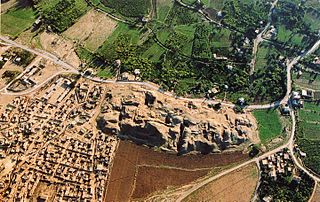
Tell es-Sultan, also known as Tel Jericho or Ancient Jericho, is an archaeological site and a UNESCO World Heritage Site in the State of Palestine, in the city of Jericho, consisting of the remains of the oldest fortified city in the world.

Jarmuth, Hebrew: Yarmut (יַרְמוּת), was the name of two cities in the land of Canaan.
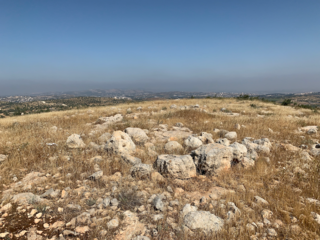
The so-called Bull Site is a 12th-century BCE open air ancient cult installation found at Dhahrat et-Tawileh, in the West Bank. The site is named for the bronze sacred bull statuette which was found at the site in 1977.
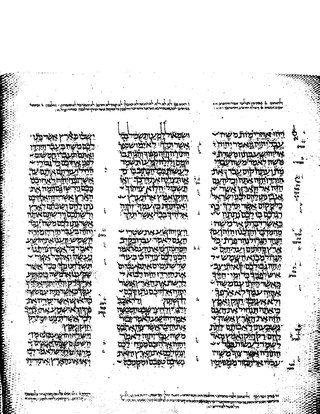
Joshua 8 is the eighth chapter of the Book of Joshua in the Hebrew Bible or in the Old Testament of the Christian Bible. According to Jewish tradition the book was attributed to the Joshua, with additions by the high priests Eleazar and Phinehas, but modern scholars view it as part of the Deuteronomistic History, which spans the books of Deuteronomy to 2 Kings, attributed to nationalistic and devotedly Yahwistic writers during the time of the reformer Judean king Josiah in 7th century BCE. This chapter focuses on the conquest of Ai under the leadership of Joshua and the renewal of covenant on Mounts Ebal and Gerizim, a part of a section comprising Joshua 5:13–12:24 about the conquest of Canaan.

Judith Marquet-Krause was an Israeli archaeologist, who was a pioneer in the archaeology of Israel and one of the first archaeologists born there. She led excavations at Et-Tell, where the Canaanite city of Ai was located.